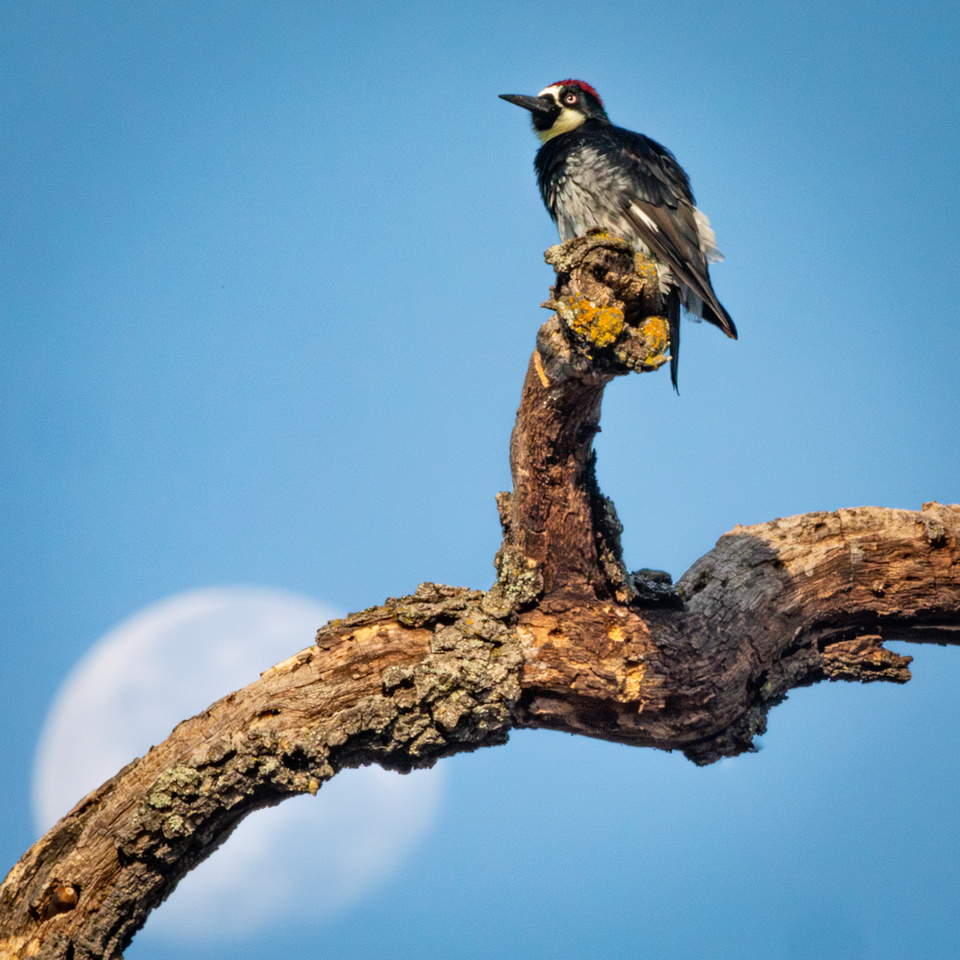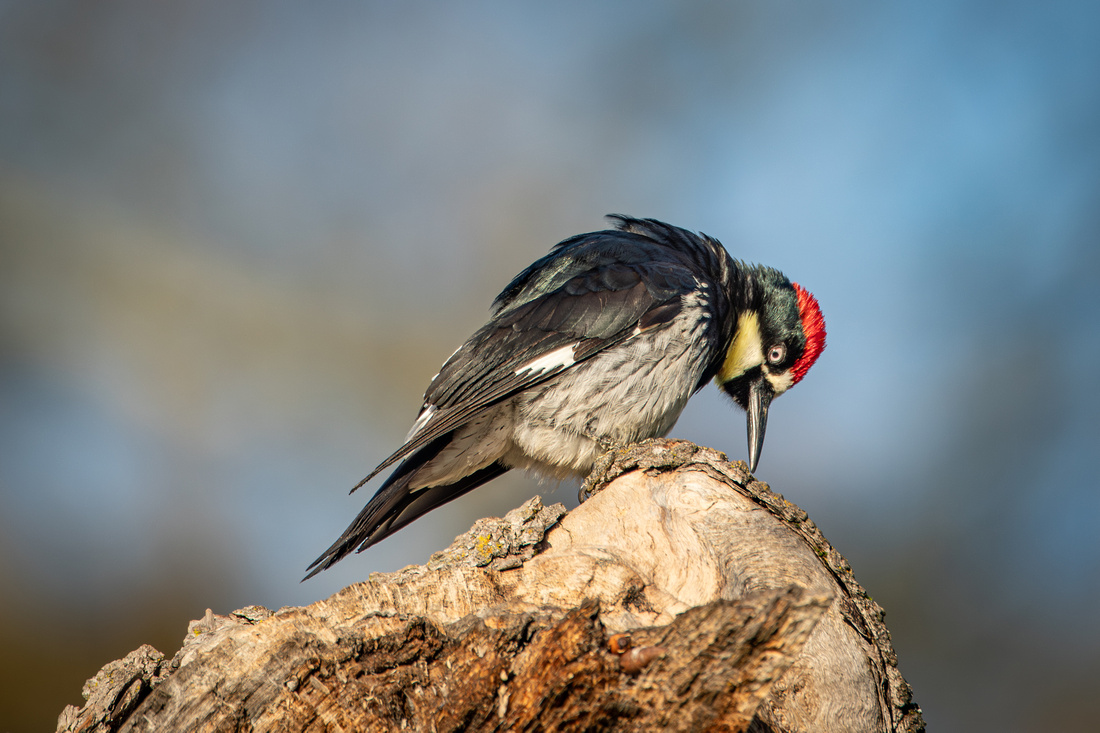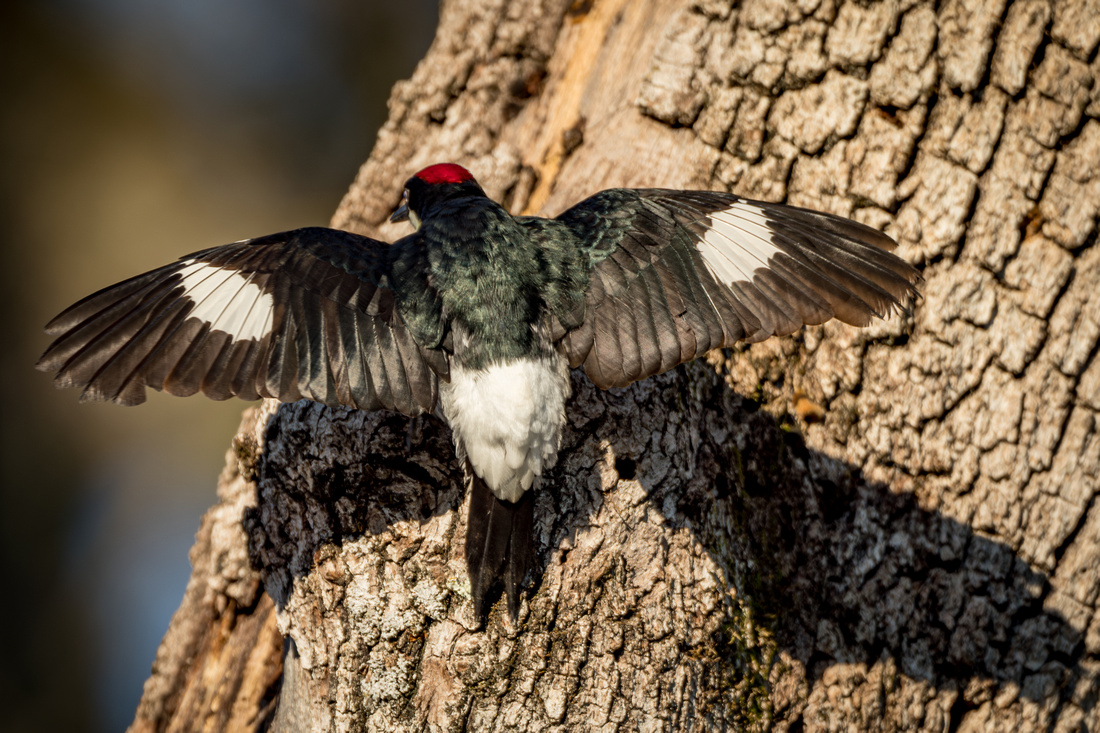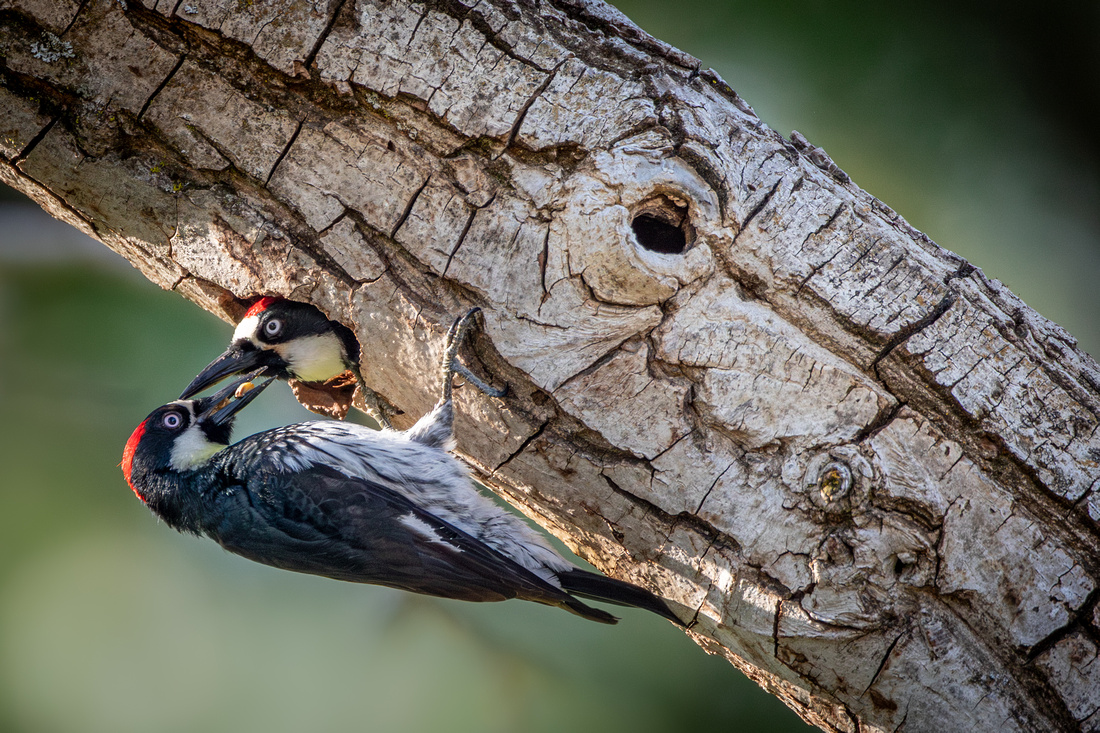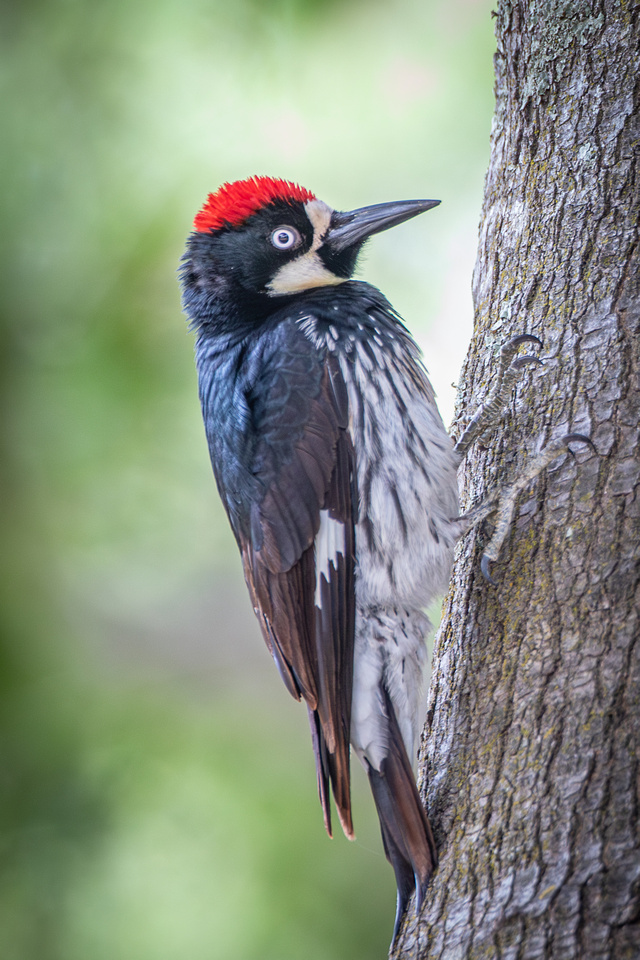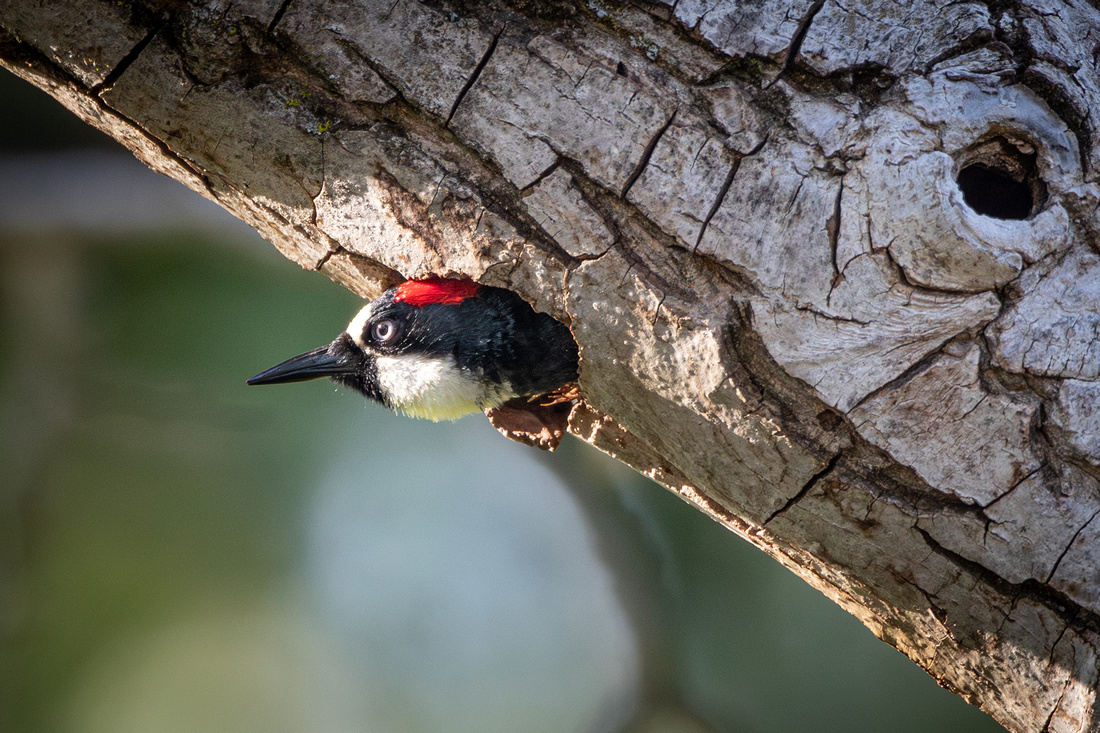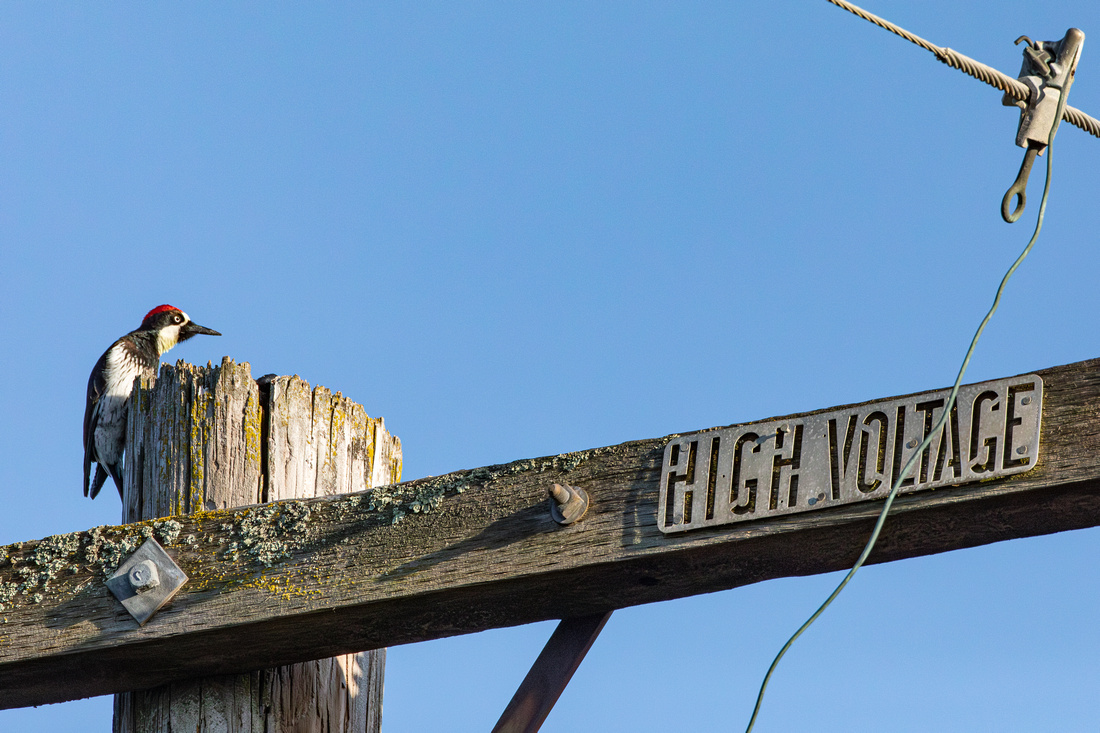Species Highlight: Acorn Woodpeckers
Species Highlight: Acorn Woodpeckers
Text and photos by Heather Cline
The Acorn Woodpecker is a fascinating bird that has an almost clown like appearance compared to other species of woodpeckers. This species is quite active in their gathering and storing of acorns and can provide some interesting viewing opportunities. Interestingly, their scientific name, Melanerpes formicivorous, means “the black creeper that eats ants."
I live near some oak woodlands, observing these birds on a regular basis and thought I would share some photos and fun facts.
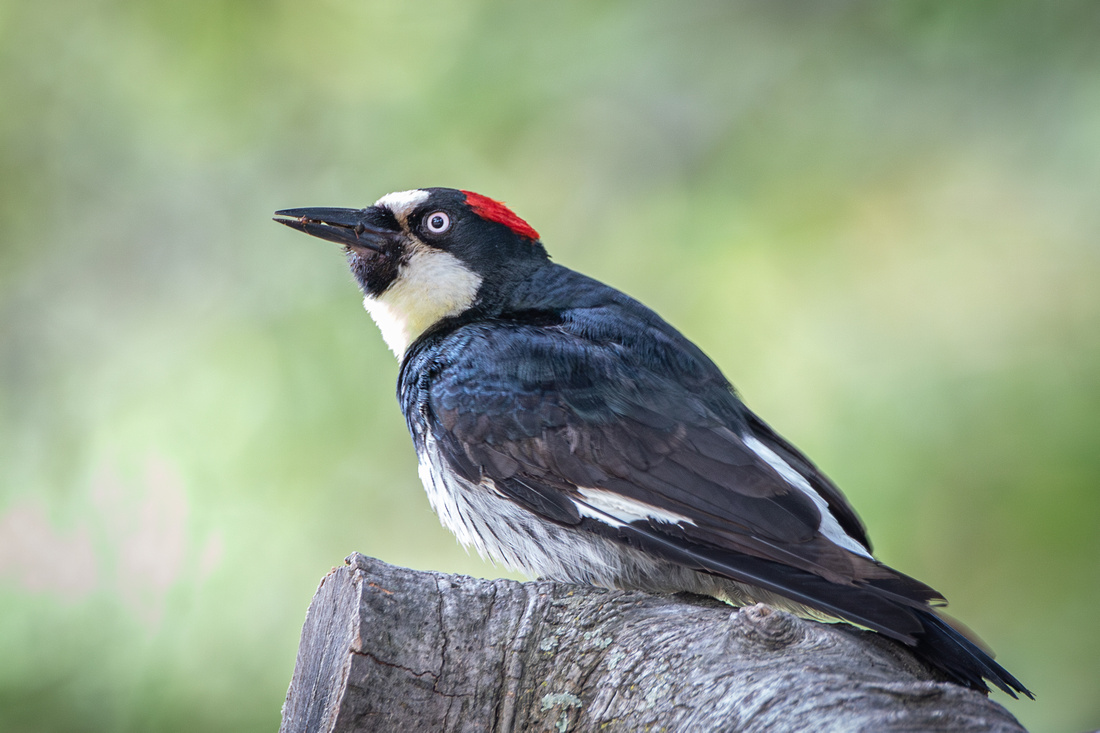 Acorn WoodpeckerAcorn Woodpecker (female)
Acorn WoodpeckerAcorn Woodpecker (female)
Acorn Woodpecker (female)
Size
- Roughly 8 inches long, with a wingspan of 17 inches, weighing approximately 3 oz.
Acorn Woodpecker (male)
Lifespan
- 9-16 years
- Oldest on record was at least 17 years old, identified in 2009 by its colored leg band, which it had been wearing since 1992.
Acorn Woodpecker (male)
Anatomy & Physical Characteristics
- All species of woodpeckers have a skull that is thick and shock-absorbing, to enable them to to withstand constant hammering into trees.
- The base of their tongue wraps around the skull, anchoring behind the nostrils, and extends far enough to reach deep into wood-bores to catch food.
- Feet: zygodactyl, which means two toes forward and two toes backward, and are ideally adapted to climbing trees. Their stiff tail props them upright while they climb the tree and drill holes.
- Markings:
- Adult birds have a brownish-black head, back, wings and tail, white forehead, throat, belly, and rump.
- Their eyes are white.
- There is a small part on the small of their backs where there are some green feathers.
- Adult males have a red cap starting at the forehead, whereas females have a black area between the forehead and the cap.
- The white neck, throat, and forehead patches are distinctive identifiers.
- White circles on their wings are visible when in flight.
Acorn Woodpecker wing markings
Speed & Agility
- Acorn woodpeckers are agile in flight, adept at catching flying insects above the canopy. When flying, Acorn woodpeckers take a few flaps of their wings and drop a foot or so.
Acorn woodpecker (female) in flight
Diet
Acorn woodpeckers feed mostly on insects, fruits, sap, corn, flower nectar - and of course: acorns.
Acorns are harvested directly from oak trees and are stored in individually drilled holes in one or more storage trees known as granaries. Trees can have up to 50,000 nuts stored in them.
The birds drill the holes primarily in the winter, in the thick bark of dead limbs where the drilling does no harm to a living tree. Each year they reuse old holes and add some new ones. The acorns are wedged so tightly in their holes that they’re very difficult for other animals to remove. After some time, the acorn dries out becoming smaller so group members periodically check their stored acorns and move the loose ones to smaller holes.
Woodpeckers may also store almonds, walnuts, hazelnuts, pecans, and pinyon pine nuts in these holes.
Acorn Woodpeckers fiercely defend their acorn granaries against other groups and any other species that might rob the stores, including a 15-acre territory around the granary. They occasionally wander outside the territory in pursuit of acorns and water.
Backyard feeding tip: Acorn Woodpeckers may visit seed and suet feeders near oak woodlands within their range.
Acorn woodpecker (female) working on a hole in the granary
Social and Breeding Behaviors
Acorn Woodpeckers have a complicated social behavior and have been part of the longest-running behavioral studies of birds.
They live in family groups of up to a dozen or more individuals, and they cooperate in raising young and in gathering, storing, and guarding food. Some groups have multiple breeding males and females, and all of a group’s breeding females lay their eggs in a single nest. Young woodpeckers stay with their parents for several years and help the parents raise more young.
Courtship displays include bowing and wing spreading, and some flight displays.
Acorn Woodpeckers excavate multiple cavities which may be used for nesting. They dig cavities in dead or living limbs and reuse nest holes for many years. The nest cavity is usually about 6 inches in diameter, and it may be 8 inches to more than 2 feet deep. Acorn Woodpeckers do not build a nest within the cavity, but during the digging process a layer of fresh wood chips usually accumulates on the bottom. They replenish the chips throughout the nesting period by pecking away at the cavity walls.
Each female destroys any eggs that are present before she begins laying, resulting in the demise of more than one-third of the total eggs laid in joint nests. Once all the females have started laying their own eggs, their destructive behavior stops and they remove the debris to a nearby tree. There each egg is gradually eaten by several individuals—often including the female who laid it.
Birds that help at nests but don’t get to breed often go out looking for breeding vacancies in other groups, up to about 10 miles away.
This species produces one brood per season, rarely two.
- Clutch size: 3-6 eggs
- Incubation period: 11 days
- Nestling period: 30-32 days
Acorn woodpecker pair at nest
Communication
Acorn woodpeckers frequently produce greeting calls with members of their own group, but not with members of other groups
Their most common call is a loud, squeaky waka-waka-waka, used for greeting family members, disputing territory boundaries, and squabbling in groups. They also give noisy trills, harsh repeated notes, chatters, and other calls.
Acorn Woodpeckers also drum on dead limbs chosen for their resonance. Both males and females drum, giving 2–20 evenly spaced taps. They drum throughout the year but more frequently during the spring, as a territorial behavior. As with other woodpeckers, the drumming sound functions like a song, and is not associated with feeding.
Acorn woodpecker (male)
Range and habitat
Acorn Woodpeckers live year-round in oak and pine-oak woodlands of western Oregon, California, and the Southwest through Mexico and Central America. They also live in other habitats with oaks present or nearby, including streamside forests, Douglas-fir forests, redwood forests, tropical hardwood forests, suburban areas, and urban parks. Though found as low as sea level, they are more common in mountains, ranging up to the elevation limit of oak trees.
Acorn woodpecker (female) peering out of nesting cavity
Predators and Threats
Acorn Woodpecker population is estimated globally at 7.5 million
While Acorn Woodpeckers are common in oak woodlands, their numbers have probably declined since historic times because of development and habitat degradation, including overgrazing and loss of oaks due to disease and habitat conversion. Oak, pine-oak, and streamside forest has been converted to other uses throughout the Acorn Woodpecker’s range.
In the Southwest and parts of Mexico, overgrazing has damaged mountain pine-oak habitats and streamside forests, probably reducing the Acorn Woodpecker population substantially. California populations, though not currently declining, have an uncertain future because of slow oak forest regeneration.
Other threats include having nest holes taken over by European Starlings, an aggressive introduced species. Occasionally, people shoot Acorn Woodpeckers to keep them from eating nut and fruit crops. However, Acorn Woodpeckers have also shown the ability to colonize new habitats such as suburban neighborhoods, using human-made structures for roosting and acorn storage.
Injured or Orphaned: a rehabilitated woodpecker must be returned to it's family within 2 weeks of being removed or it will be replaced by another and rejected by the family, increasing risk of starvation.
Acorn woodpecker (male) in suburban neighborhood
While Acorn woodpeckers are one of the more common birds in the oaks woodlands, they are worthy of observation. Their gregarious nature, persistent gathering and storing of acorns, and consistent chatter make them a fun species to watch and photograph.
I hope you enjoyed this post, and if you would like to see any of my other Acorn Woodpecker photos, please check out my gallery.
Comments
Thank you!
